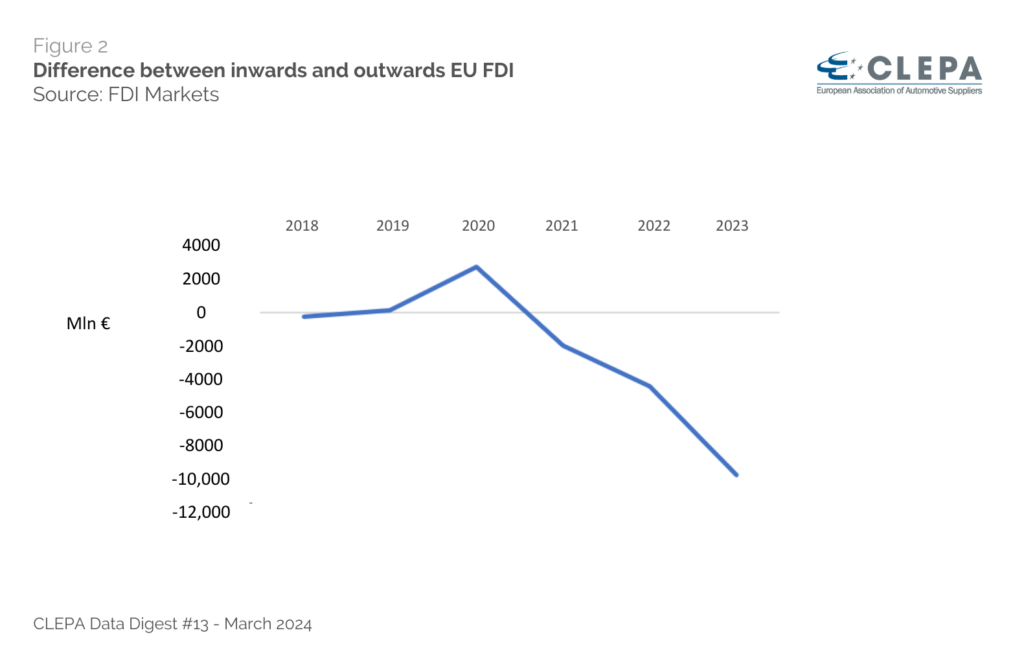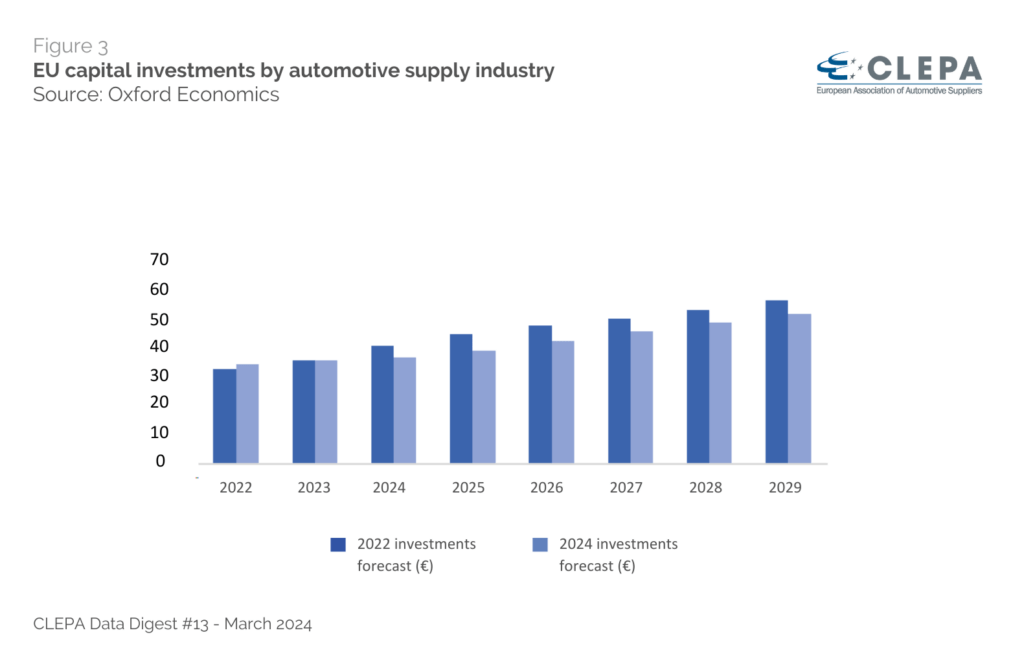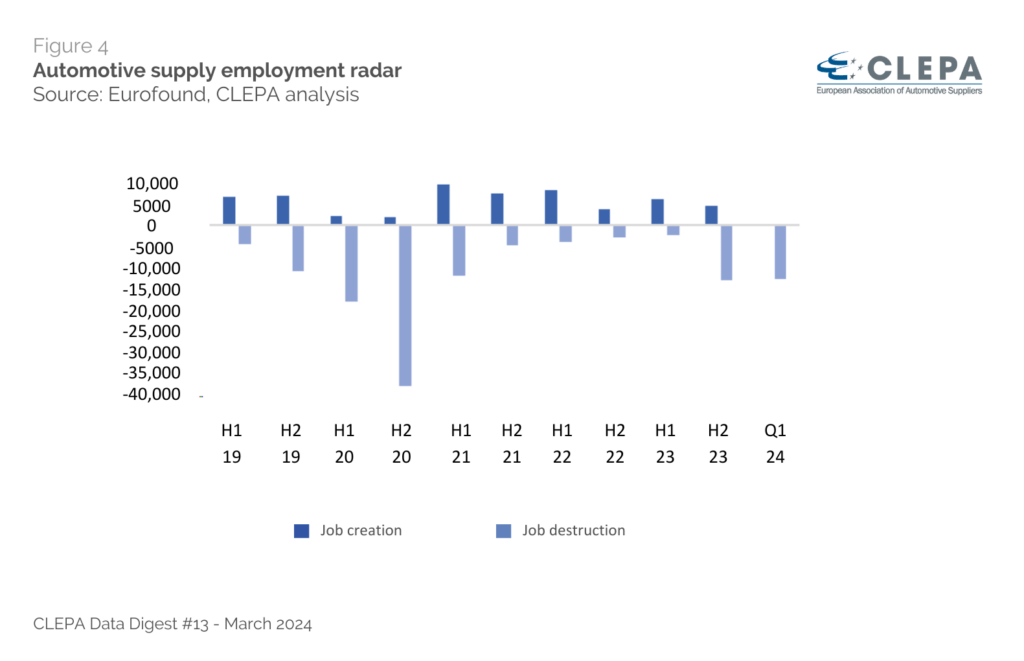Published on 19.03.2024
CLEPA DATA DIGEST #13 – Job losses rise, as investments shift abroad

Edition #13 – DATA DIGEST is CLEPA’s bi-monthly publication shedding light on the health and resilience of the European automotive supply industry through latest facts and figures
Job losses rise, as investments shift abroad
European suppliers forced to cut employment and postpone investments
Regarding foreign direct investments (FDI), the US has significantly outpaced the EU, attracting three times the amount of FDI over the past two and a half years. This discrepancy in investment, coupled with a higher rate of job cuts, falls notably short of the expectations set at the beginning of the decade.
Moreover, the decline in competitiveness is exacerbated by the growing imbalance between capital outflow and inflow. While the EU’s automotive suppliers continue to dominate FDI outside of their home markets, particularly in the US battery supply chain, inbound investments no longer match Europe’s once formidable FDI prowess. The surplus of more than €2.5 billion in 2020 has dwindled to a deficit of nearly €10 billion in 2023.
The postponement of investments in production equipment, plants, facilities and other capital goods is evident, illustrated by a staggering €27 billion decrease in expected capital expenditure until 2029. Even more concerning is the failure of expected job growth to materialise in the industry. Since 2019, nearly 118,000 jobs have been lost, while only 55,000 new positions have been created.
What you will find in this edition
EU suppliers continue to invest significantly in the green and digital transformation, however, this investment increasingly takes place outside of the EU. This not only affects the automotive industry, but also industries that depend on it, from steel to chemicals and the semiconductor sector.

Nils Poel
CLEPA’s Head of Market Affairs
The EU attracted over €10 billion in investment from non-European companies, driven largely by investments into the battery supply chain, over the past year. Nevertheless, the EU’s share of global FDI fell for a second time in a row during the last six months of 2023.
Since H2 of 2022, the EU has experienced a 15.2 percentage point decrease in its share of global FDI, while the US’ share has been rising. Since H2 of 2021, FDI into the US has reached €65.2 billion – almost three times the amount entering the EU (€20.2 billion) over the same period.

Since 2020, the EU’s deficit in terms of FDI has been growing. EU companies now invest significantly more outside of the EU than what is gained in FDI from abroad. In 2023, EU suppliers invested close to €20 billion outside of the EU, while the region attracted less than €10 billion from foreign companies.
Europe is making significant investments in battery supply chains in the NAFTA area (US, Canada and Mexico). European firms initiated four out of ten largest battery plant projects in North America since 2021, which collectively represent an investment of nearly €17 billion. Overall, European investments have accounted for 35% of total FDI in the NAFTA battery supply chain since 2021.

European suppliers allocated over €35 billion for buildings, production equipment, and other capital assets in 2023. Despite this substantial investment, projections for future capital expenditure (CAPEX) are significantly lower than forecasts from two years ago. A total of €27 billion has already been cut from the projected CAPEX between 2022-2029.
Forecasts indicate that real annual investments (excluding inflation) for 2029 are expected to reach €40 billion – a €5 billion increase from 2023, but still more than €3 billion lower than expected two years ago.

A rise in job losses and declining foreign direct investment are clear warning signs for the future automotive industry and calls for a new industrial deal in Europe.

Benjamin Krieger
CLEPA’s Secretary General
2023 was a difficult year for employment in the automotive supply industry. The loss of 14,429 jobs was only met with the creation of some 10,500 jobs, and 2024 is continuing the downward trend. In the first two months of this year, a staggering loss of 12,153 jobs was announced, primarily due to internal restructuring, while only 100 jobs have been created, leaving no sign of reversing this trend.
Since 2019, nearly 118,000 jobs have been lost, and only 55,000 new positions have been created. Beginning in H2 of 2023, the rate of net job creation has stayed negative.
Forecasts from 2021 suggested a net job creation of 101,000 by 2025, driven by electrification and a stricter Euro 7 regulation. However, job losses in the last five years currently outnumber job creation by more than 60,000 jobs.

Are you interested in knowing more?
Contact CLEPA Communications Team at communications@clepa.be
Subscribe now to receive CLEPA’s latest communication
Attachments
In: CLEPA News



